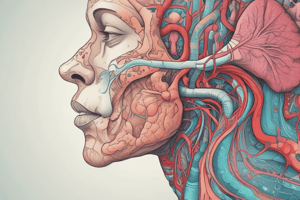Podcast
Questions and Answers
What are vessels going away from the heart called?
What are vessels going away from the heart called?
- Aorta
- Veins
- Capillaries
- Arteries (correct)
What is the lung with two lobes?
What is the lung with two lobes?
left
What is the lung with three lobes?
What is the lung with three lobes?
right
What is the thick fluid in sinuses?
What is the thick fluid in sinuses?
What element is fundamental to living things?
What element is fundamental to living things?
What is the windpipe called?
What is the windpipe called?
Bronchial ______
Bronchial ______
What protects the lungs and heart?
What protects the lungs and heart?
What are tiny hairs called?
What are tiny hairs called?
What is the process of letting out air called?
What is the process of letting out air called?
What are the air sacs in the lungs called?
What are the air sacs in the lungs called?
What carries oxygen in the body?
What carries oxygen in the body?
What describes sinuses?
What describes sinuses?
What term describes the act of using air?
What term describes the act of using air?
What are the organs for breathing called?
What are the organs for breathing called?
What is the opening for air called?
What is the opening for air called?
What membranes cover the lungs?
What membranes cover the lungs?
What is a 4-chambered organ?
What is a 4-chambered organ?
What is the bone-like substance found in the body?
What is the bone-like substance found in the body?
What do we breathe?
What do we breathe?
What is part of a lung called?
What is part of a lung called?
What are vessels that return blood to the heart called?
What are vessels that return blood to the heart called?
How would you describe breathing?
How would you describe breathing?
What element do we need to live?
What element do we need to live?
Flashcards
Arteries
Arteries
Blood vessels that carry oxygenated blood away from the heart.
Left Lung
Left Lung
Smaller lung, with two lobes, accommodating the heart.
Right Lung
Right Lung
Larger lung, with three lobes, optimized for gas exchange.
Mucus
Mucus
Signup and view all the flashcards
Trachea
Trachea
Signup and view all the flashcards
Bronchial Tubes
Bronchial Tubes
Signup and view all the flashcards
Rib Cage
Rib Cage
Signup and view all the flashcards
Cilia
Cilia
Signup and view all the flashcards
Expiration
Expiration
Signup and view all the flashcards
Alveoli
Alveoli
Signup and view all the flashcards
Blood
Blood
Signup and view all the flashcards
Sinuses
Sinuses
Signup and view all the flashcards
Breathing
Breathing
Signup and view all the flashcards
Lungs
Lungs
Signup and view all the flashcards
Mouth
Mouth
Signup and view all the flashcards
Pleura
Pleura
Signup and view all the flashcards
Heart
Heart
Signup and view all the flashcards
Cartilage
Cartilage
Signup and view all the flashcards
Oxygen
Oxygen
Signup and view all the flashcards
Automatic Breathing
Automatic Breathing
Signup and view all the flashcards
Veins
Veins
Signup and view all the flashcards
Lobe
Lobe
Signup and view all the flashcards
Study Notes
Key Components of the Respiratory System
- Arteries: Blood vessels that transport oxygenated blood away from the heart to various body parts.
- Left Lung: Comprised of two lobes, smaller than the right lung to accommodate the heart.
- Right Lung: Contains three lobes, larger than the left lung to optimize gas exchange.
Respiratory Functions and Terminology
- Mucus: Thick fluid produced in sinuses, helps trap pathogens and particles, maintaining respiratory health.
- Carbon: An essential element in organic compounds, vital for life.
- Trachea: Also known as the windpipe, a crucial airway leading from the larynx to the bronchi.
Anatomical Structures
- Bronchial Tubes: Airways that branch from the trachea into each lung, facilitating airflow.
- Rib Cage: Bone structure protecting vital organs, including the lungs and heart, supports respiratory movement.
- Cilia: Tiny hair-like structures lining the respiratory tract, work to filter and clean inhaled air.
Breathing Mechanisms
- Expiration: The process of letting out air from the lungs, crucial for maintaining gas exchange.
- Alveoli: Tiny air sacs in the lungs where oxygen and carbon dioxide exchange occurs, vital for respiration.
- Blood: Transports oxygen from the lungs to cells and carries carbon dioxide back to be exhaled.
Sinus and Lung Characteristics
- Cavities: Spaces within the skull, called sinuses, that contribute to resonance and lighten the weight of the head.
- Breathing: The act of inhaling oxygen and exhaling carbon dioxide, a fundamental process for sustaining life.
- Lungs: Main organs for gas exchange in the body, essential for respiration.
Openings and Membranes
- Mouth: One of the primary openings for air intake, plays a role in respiration and speech.
- Pleura: Membranes surrounding the lungs, providing a smooth surface for movement during breathing.
- Heart: A four-chambered organ responsible for pumping blood throughout the body, coordinating with the lungs for oxygenation.
Supporting Structures and Elements
- Cartilage: A flexible, bone-like tissue providing structure to the trachea and bronchi, preventing airway collapse.
- Air: Mixture of gases we breathe, primarily oxygen and nitrogen, necessary for human life.
- Lobe: A division of the lungs, important for organizing lung tissue and facilitating specific respiratory functions.
Oxygen Requirements
- Veins: Blood vessels that carry deoxygenated blood back to the heart from various parts of the body.
- Automatic: Breathing is an involuntary process, controlled by the brainstem, ensuring steady oxygen supply.
- Oxygen: A vital gas required for cellular respiration, fundamental for energy production in living organisms.
Studying That Suits You
Use AI to generate personalized quizzes and flashcards to suit your learning preferences.



